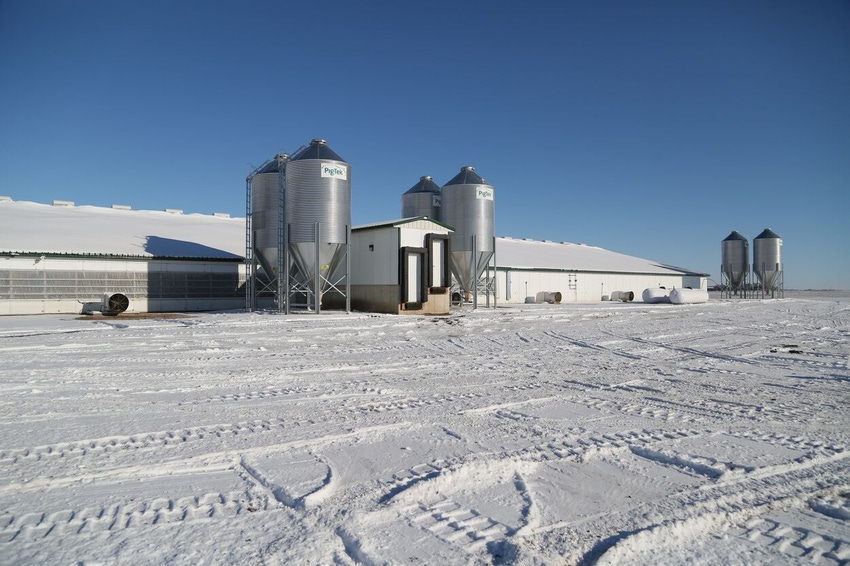Because of bitterly cold weather, last week's hog slaughter was down 8.12%.

USDA's December Hogs and Pigs report was released Friday afternoon, with no surprises in the report. USDA's numbers were within one percentage point of pre-release trade predictions. At 98%, the market hog inventory was 0.4% smaller than expected while the breeding herd, at 100.5%, was 0.8% larger than trade forecasts.
This is a slightly bullish report. The Dec. 1 hog inventory is the lowest since 2016.
The market hog weight group inventories as a percent of last year were: 180 pounds and up 98.1%, 120-179 pounds 98.1%, 50-119 pounds 98.0% and under-50 pounds group at 98.0% of the year-ago level. If these numbers are correct, hog slaughter will be down 2% over the next five months.
Normally, the first check on the accuracy of the quarterly Hogs and Pigs report is the matchup between the heavy-weight market hog inventory and recent hog slaughter. Since the hogs and pigs inventory survey is as of Dec. 1, a good portion of the heavy-weight inventory has gone to slaughter before the report is released. However, this year cold weather has disrupted hog flow. Hog slaughter the week of Dec. 3 was down 2.72%, the week of Dec. 10 was up 0.12%, the week of Dec. 17 was down 2.38%. Because of bitterly cold weather, last week's hog slaughter was down 8.12%.
The last two Hogs and Pigs reports have been remarkably accurate. Over the last 17 weeks hog slaughter has been down 1.84% (down 1.5% if last week is excluded). The September Hogs and Pigs report indicated slaughter would be down 1.4%.
USDA made some small revisions to past reports to align them with hog slaughter. The September market hog groups were revised down. The 180-pound plus market hog group was lowered 0.4%, the 120-179 pound group also was lowered 0.4%, the 50-119 group was lowered 0.5%. But the under-50 pound group was left unchanged.
Correspondingly small downward revisions were made in the light weight market hog inventory in the June report. The June 50-119 pounds group was revised down by 0.2% and the June under-50 pounds group was revised down by 0.9%. The spring and summer pig crops were lowered a bit as were the spring and summer litters farrowed.
It looks like 2023 hog slaughter will be even to slightly below this year's level. As to whether pork production will be up or down in 2023, a lot depends on what happens to slaughter weights. Hog weights typically increase from year to year. USDA has been predicting 2023 pork production will be less than in 2021 but more than in 2022.
High feed costs are likely to be a drag on slaughter weights. Cost of production was higher each month than in 2021. USDA is estimating corn will average $6.70 per bushel for the September 2022 through August 2023 marketing year. USDA says the average price received by corn growers in the 2021-22 marketing year was $6/bu.
Fall (September-November) sows farrowed were down 1.48%. Fall pigs per litter averaged 11.22 head, up 0.27% from a year ago and a new record for any quarter. This left the fall pig crop down 1.27%.
Winter (December-February) farrowing intentions are up 0.96%. If pigs per litter are up 0.27% again then the winter pig crop is likely to be up 1.2% causing summer 2023 hog slaughter to also be up 1.2%.
Spring (March-May) farrowing intentions are up 0.47%. If pigs per litter are up 0.27% then the spring pig crop is likely to be up 0.74% as should be fall hog slaughter.
Sows farrowed in June-August were the lowest for that quarter since 2014. Sows farrowed in September-November were the lowest since 2015.
Cold storage stocks of pork are up. At the end of November there were 454 million pounds of pork in cold storage, up 12% year-over-year and the eighth consecutive month up by 10% or more than 10%.
The national average live price for 51-52% lean hogs averaged $63.72/cwt in November, down $4.06 from the month before, up $9.19 from a year earlier, and the lowest month since January 2022. Liveweight prices for 51-52% lean hogs averaged $67.29/cwt in 2021. USDA is forecasting 2022 at $71.33/cwt and 2023 at $67/cwt. Their quarterly price forecast for 2023 is: first quarter $63/cwt, second quarter $71/cwt, third quarter $69/cwt and fourth quarter $65/cwt. The record high live price for 51-51% lean hogs is $95.17/cwt in July 2014.
Lean hog futures contracts are forecasting a steady rally in carcass hog prices from $87/cwt in February to $109/cwt in July then sliding back to a low of $84/cwt in December.
Through October U.S. pork exports were down 715 million pounds (12.1%). Most of the decrease was due to a 574 million pounds drop in shipments to China. Shipments to Mexico were up 263 million pounds.
Pork imports were up 217 million pounds (23.2%) with more than half the increase coming from Canada. Live hog imports were down 113,383 head (2.0%).
USDA anticipates little change in pork imports or exports in 2023.
Calculations by Lee Schulz at Iowa State University indicate Iowa farrow-to-finish hog operations lost money on hog sales during January, November and December 2022. This is not surprising since hog prices are typically lowest during the winter.
About the Author(s)
You May Also Like





